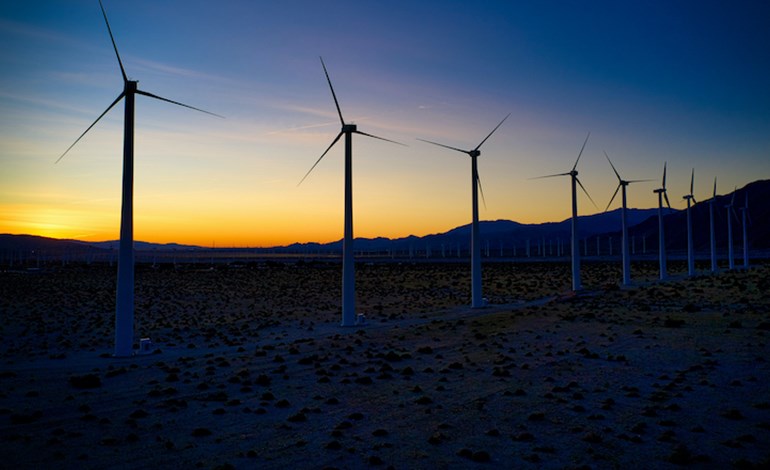QUESTA : It won’t replace the shuttered molybdenum mine that was once the community’s economic backbone, but a hydrogen project under consideration in Questa would be another significant step toward Kit Carson Electric Cooperative’s goal of providing 100% carbon-free electricity for its customers.
In 2022, Questa became one of 24 communities across the U.S. that has received a Department of Energy Local Energy Action Program grant. The former mining community chose to investigate the benefits of using effluent from the massive Chevron Mine wastewater treatment plant to generate electrolytic hydrogen, commonly, referred to as green hydrogen.
Green hydrogen — as opposed to blue hydrogen derived from natural gas, for example — requires three ingredients: land on which to build a facility, water and fossil-free power.
Since June 2022, Kit Carson has generated its daytime electricity almost exclusively from local solar arrays, with about 5% derived from a wind farm in Colorado.
“I think the benefit is that all this is local,” said Luis Reyes, Kit Carson’s CEO, noting the co-op lowered its rates last year. “And now we’re focusing on storage. That’s why hydrogen is so important.”
A feasibility study found developing a hydrogen facility in Questa could supply between 8% and 10% of Kit Carson’s total network demand, while providing 10 permanent jobs. Along with the large battery storage the co-op is pairing up with its solar fields, it hopes to rely on green hydrogen as a method of storing solar power.
Currently, the co-op’s customers receive energy derived from solar power during the day, followed by a brief period of battery power after the sun goes down.
“They operate for two hours, then we go on grid power,” Reyes said, adding long-term energy storage is the No. 1 goal of the renewable energy industry.
“The most you can get is four hours,” he said. “This Questa proposal is for a 36-hour battery” that would use hydrogen created onsite from effluent discharged by the Chevron Mine Superfund site wastewater treatment plant, or excess water rights Chevron has.
According to the study, the 9 gigawatt project would use an estimated 5 acre-feet of water per year, plus around 2.5 acre-feet for cooling and other applications, an amount equal to the average annual water usage of about 30 households.
“The new strategy would be to have solar, which covers 100% [of daytime energy demand], followed by two hours of battery — and we’re putting more batteries — and then the hydrogen would take the rest of the night,” Reyes said.
According to the feasibility study, the Questa facility would allow Kit Carson to avoid the equivalent of 456 metric tons of carbon dioxide produced by fossil fuel-derived electricity.
“What we’re trying to do is, in the process of creating jobs [and] increasing our tax revenue, we’re also turning brownfields into greenfields,” Questa Mayor John Ortega told an audience of around 50 residents who participated in a recent public information meeting.
Ortega said the brownfield where the hydrogen plant would sit could never be used for “a playground, baseball field or a lake.”
“But it does bode well for solar panels; it does bode well for a green hydrogen plant,” he said.
“We also want to say we’re 100% renewable, right?” Ortega added. “We can be the first community in the United States to say that.”
Reyes is confident a majority of funding for the estimated $44.5 million project could be secured through the nearly
$10 billion in clean energy funding allocated to the federal Rural Utility Service in President Joe Biden’s Inflation Reduction Act, although he acknowledged co-op members could bear some cost if the project comes to fruition.
Chief among local residents’ concerns: How much water would be consumed by the hydrogen plant, and what if it blows up?
“I’m all for green energy, but I see that hydrogen is explosive, right?” Annette Dickson said at the community meeting. She suggested Questa would be better off developing wind power or learning to use less energy.
Kevin Topolski, a hydrogen infrastructure analyst with the National Renewable Energy Laboratory, and Chrissy Scarpitti, a resilience researcher with the lab, led the presentation.
Topolski said there would be no combustion involved in any part of the project, and no trucks or other means of exporting hydrogen are involved. “Developing mitigation safety: These are the aspects that we put safeguards in front of to prevent such a catastrophic incident like that happening,” he said.
Scarpitti said hydrogen fires are invisible during daylight and said special training would be required for staff.
She also told residents the “source of the water hasn’t been determined yet.”
“We’re considering the use of Chevron’s water or some potential purchase, transfer or trade with another potential partner,” she said. “But that would ultimately be determined by whoever decides to develop and participate in the project.”

